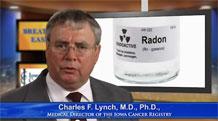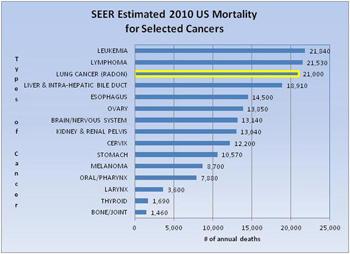Health Risk of Radon
On this page:
- Exposure to radon causes lung cancer in non-smokers and smokers alike
- Radon risk if you smoke
- Radon risk if you have never smoked
- Studies find direct evidence linking radon in homes to lung cancer
- Biological Effects of Ionizing Radiation (BEIR) VI Report: "The Health Effects of Exposure to Indoor Radon"
- 2003 EPA Assessment of Risks from Radon in Homes
- The U.S. Surgeon General issues national health advisory on radon
- World Health Organization's international radon project
- Radon-related lung cancer deaths compared to other select cancers
Exposure to Radon Causes Lung Cancer In Non-smokers and Smokers Alike
The Facts...
- Lung cancer kills thousands of Americans every year. Smoking, radon, and secondhand smoke are the leading causes of lung cancer. Although lung cancer can be treated, the survival rate is one of the lowest for those with cancer. From the time of diagnosis, between 11 and 15 percent of those afflicted will live beyond five years, depending upon demographic factors. In many cases lung cancer can be prevented.
- Smoking is the leading cause of lung cancer. Smoking causes an estimated 160,000* cancer deaths in the U.S. every year (American Cancer Society, 2004). And the rate among women is rising. On January 11, 1964, Dr. Luther L. Terry, then U.S. Surgeon General, issued the first warning on the link between smoking and lung cancer. Lung cancer now surpasses breast cancer as the number one cause of death among women. A smoker who is also exposed to radon has a much higher risk of lung cancer.
- Radon is the number one cause of lung cancer among non-smokers, according to EPA estimates. Overall, radon is the second leading cause of lung cancer. Radon is responsible for about 21,000 lung cancer deaths every year. About 2,900 of these deaths occur among people who have never smoked. On January 13, 2005, Dr. Richard H. Carmona, the U.S. Surgeon General, issued a national health advisory on radon.
- Secondhand smoke is the third leading cause of lung cancer and responsible for an estimated 3,000 lung cancer deaths every year. Smoking affects non-smokers by exposing them to secondhand smoke. Exposure to secondhand smoke can have serious consequences for children’s health, including asthma attacks, affecting the respiratory tract (bronchitis, pneumonia), and may cause ear infections.
- For smokers the risk of lung cancer is significant due to the synergistic effects of radon and smoking. For this population about 62 people in a 1,000 will die of lung-cancer, compared to 7.3 people in a 1,000 for never smokers. Put another way, a person who never smoked (never smoker) who is exposed to 1.3 pCi/L has a 2 in 1,000 chance of lung cancer; while a smoker has a 20 in 1,000 chance of dying from lung cancer.
Radon Risk If You Smoke
from "A Citizen's Guide to Radon: The Guide to Protecting Yourself and Your Family From Radon"
| Radon Level | If 1,000 people who smoked were exposed to this level over a lifetime*... | The risk of cancer from radon exposure compares to**... | WHAT TO DO: Stop smoking and... |
|---|---|---|---|
| 20 pCi/L | About 260 people could get lung cancer | 250 times the risk of drowning | Fix your home |
| 10 pCi/L | About 150 people could get lung cancer | 200 times the risk of dying in a home fire | Fix your home |
| 8 pCi/L | About 120 people could get lung cancer | 30 times the risk of dying in a fall | Fix your home |
| 4 pCi/L | About 62 people could get lung cancer | 5 times the risk of dying in a car crash | Fix your home |
| 2 pCi/L | About 32 people could get lung cancer | 6 times the risk of dying from poison | Consider fixing between 2 and 4 pCi/L |
| 1.3 pCi/L | About 20 people could get lung cancer | (Average indoor radon level) | (Reducing radon levels below 2 pCi/L is difficult.) |
| 0.4 pCi/L | About 3 people could get lung cancer | (Average outdoor radon level) | |
| Note: If you are a former smoker, your risk may be lower. * Lifetime risk of lung cancer deaths from EPA Assessment of Risks from Radon in Homes (EPA 402-R-03-003). ** Comparison data calculated using the Centers for Disease Control and Prevention's 1999-2001 National Center for Injury Prevention and Control Reports. |
|||
Radon Risk If You Have Never Smoked
| Radon Level | If 1,000 people who never smoked were exposed to this level over a lifetime*... | The risk of cancer from radon exposure compares to**... | WHAT TO DO: |
|---|---|---|---|
| 20 pCi/L | About 36 people could get lung cancer | 35 times the risk of drowning | Fix your home |
| 10 pCi/L | About 18 people could get lung cancer | 20 times the risk of dying in a home fire | Fix your home |
| 8 pCi/L | About 15 people could get lung cancer | 4 times the risk of dying in a fall | Fix your home |
| 4 pCi/L | About 7 people could get lung cancer | The risk of dying in a car crash | Fix your home |
| 2 pCi/L | About 4 person could get lung cancer | The risk of dying from poison | Consider fixing between 2 and 4 pCi/L |
| 1.3 pCi/L | About 2 people could get lung cancer | (Average indoor radon level) | (Reducing radon levels below 2 pCi/L is difficult.) |
| 0.4 pCi/L | (Average outdoor radon level) | ||
| Note: If you are a former smoker, your risk may be higher. * Lifetime risk of lung cancer deaths from EPA Assessment of Risks from Radon in Homes (EPA 402-R-03-003). ** Comparison data calculated using the Centers for Disease Control and Prevention's 1999-2001 National Center for Injury Prevention and Control Reports. |
|||
Studies Find Direct Evidence Linking Radon in Homes to Lung Cancer
(2005) Two studies show definitive evidence of an association between residential radon exposure and lung cancer. Two studies, a North American study and a European study, both combined data from several previous residential studies. These two studies go a step beyond earlier findings. They confirm the radon health risks predicted by occupational studies of underground miners who breathed radon for a period of years.
Early in the debate about radon-related risks, some researchers questioned whether occupational studies could be used to calculate risks from exposure to radon in the home environment. “These findings effectively end any doubts about the risks to Americans of having radon in their homes,” said Tom Kelly, Former Director of EPA’s Indoor Environments Division. “We know that radon is a carcinogen. This research confirms that breathing low levels of radon can lead to lung cancer.”
- Read the "Iowa Radon Lung Cancer Study" Exit by Dr. William Field on radon-related lung cancer in women.
- Read the "Radon in Homes and Risk of Lung Cancer: Collaborative Analysis of Individual Data from 13 European case-control studies" Exitby Dr. David Hill.
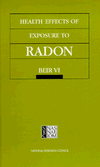
Biological Effects of Ionizing Radiation (BEIR) VI Report: "The Health Effects of Exposure to Indoor Radon"
The National Research Council published the report, entitled: "Health Effects of Exposure to Radon: BEIR VI, Committee on Health Risks of Exposure to Radon (BEIR VI)". This report by the National Academy of Sciences (NAS) is the most definitive accumulation of scientific data on indoor radon. The report confirms that radon is the second leading cause of lung cancer in the U.S. and that it is a serious public health problem. The study fully supports EPA estimates that radon causes about 15,000 lung cancer deaths per year.
The ISBN number for the book is 0-309-056454-4; National Academy Press, 516 pages, 1999. The listed hardcover price for the book is $54.95 U.S. and $66.00 Intl. The Report can be read and purchased from The National Academies Press.
Report: EPA's Assessment of Risks from Radon in Homes
In 2003 the Agency updated the estimates of lung cancer risks from indoor radon based on the National Academy of Sciences' (NAS) latest report on radon, the Biological Effects of Ionizing Radiation (BEIR) VI Report (1999). EPA worked closely with the Science Advisory Board (SAB), an independent panel of scientific experts, to determine how best to apply the risk models developed by the BEIR VI committee. The SAB's advice and recommendations were incorporated modifying and extending the methods and approaches used in BEIR VI to construct a single model yielding results midway between the results obtained using the two models preferred by the BEIR VI committee. The Agency's updated calculation of a best estimate of annual lung cancer deaths from radon is about 21,000 (with an uncertainty range of 8,000 to 45,000), which is consistent with the estimates of the BEIR VI Report. A single risk model also permitted the Agency to calculate a numerical estimate of the risk per unit exposure [lung cancer deaths per working level month (WLM)] which will be used to update estimated lung cancer risks from radon in various publications, including A Citizen's Guide to Radon.
- EPA's Assessment of Risks from Radon in Homes EPA 402-R-03-003.
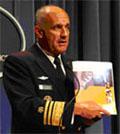
Former U.S. Surgeon General Richard H. Carmona, Releases National Health Advisory on Radon
(January 13, 2005) U.S. Surgeon General, Richard H. Carmona, issues a Health Advisory warning Americans about the health risk from exposure to radon in indoor air. The Chief Physician urged Americans to test their homes to find out how much radon they might be breathing.
Dr. Carmona also stressed the need to remedy the problem as soon as possible when the radon level is 4 pCi/L or more, noting that more than 20,000 Americans die of radon-related lung cancer each year.
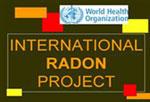
World Health Organization's International Radon Project
(2009) The World Health Organization (WHO) says radon causes up to 15% of lung cancers worldwide. In an effort to reduce the rate of lung cancer around the world, the World Health Organization (WHO) launched an international radon project to help countries increase awareness, collect data and encourage action to reduce radon-related risks.
The U.S. EPA is one of several government agencies and countries supporting this initiative and is encouraged by WHO’s attention to this important public health issue.
"Radon poses an easily reducible health risk to populations all over the world, but has not up to now received widespread attention," said Dr. Michael Repacholi, coordinator of WHO’s Radiation and Environmental Health Unit. He went on to say that "radon in our homes is the main source of exposure to ionizing radiation, and accounts for 50% of the public’s exposure to naturally-occurring sources of radiation in many countries."
- Visit the World Health Organization's International Radon Project Exit site.
Radon-related Lung Cancer Deaths Compared to Other Select Cancers
The following graphic compares EPA estimates of the annual radon-related lung cancer deaths to other selected cancers. The other mortality numbers in this graphic were obtained from the National Cancer Institute's 2010 Surveillance, Epidemiology, and End Results (SEER) estimated US mortality numbers (PDF) (1 pp, 15 K, About PDF).

